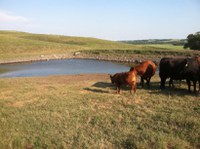Test Water Quality Before Livestock Turnout
(Click the image below to view a high-resolution image that can be downloaded)
Recent spring rains have been welcome to North Dakota farmers and ranchers following a fall and winter of below-average precipitation, but water quality in ponds and dugouts still may be compromised by concentrated levels of salts, minerals and bacteria.
“We recommend that livestock producers test water quality prior to livestock turnout,” North Dakota State University Extension Service livestock environmental stewardship specialist Miranda Meehan says.
Poor water quality can impact livestock health negatively, according to Gerald Stokka, NDSU Extension veterinarian and livestock stewardship specialist.
“At a minimum, it can result in decreased water consumption, reducing feed intake and gains,” he adds. “However, elevated levels of some salts and bacteria can result in severe illness and even death.”
NDSU veterinary toxicologist Michelle Mostrom says water sources should be tested for total dissolved solids (TDS), sulfates and nitrates.
TDS measure salts. These levels should be less than 5,000 parts per million (ppm) for most classes of grazing livestock. Elevated levels of TDS may not be harmful to livestock health.
“However, due to our geology in North Dakota, water with high TDS often has high sulfate levels,” Mostrom says.
Sulfate recommendations are less than 500 ppm for calves and less than 1,000 ppm for adult cattle. High levels of sulfate can reduce copper availability in the diet. Elevated levels of sulfates may cause loose stool, whereas very high levels of sulfate can induce central nervous system problems and polioencephelomalacia, a brain disorder found in cattle.
Nitrate is not toxic to animals, but at elevated levels, it causes nitrate poisoning. Water sources that receive runoff from fields and confined feeding locations that contain elevated levels of nitrogen are at risk of contamination.
Water with elevated nutrient levels also are at a higher risk for blue-green algae blooms in periods of hot, dry weather. Some species of blue-green algae (cyanobacteria) contain toxins that can be deadly when livestock and wildlife consume them.
“Monitoring water quality throughout the grazing season is important because it changes in response to climate and environmental conditions,” Meehan says. “What is especially important is to keep a close eye on water quality during drought when using a shallow water source and sources with a history of water quality issues.”
Many commercial laboratories and the NDSU Veterinary Diagnostic Laboratory provide testing for livestock water quality and specialized testing. The cost of a basic water quality test is approximately $25. Contact an NDSU Extension office for a list of commercial laboratories in the state.
If concerned about livestock diseases caused by contaminated drinking water, contact your local veterinarian, the NDSU Extension veterinarian or the NDSU Veterinary Diagnostic Laboratory at 701-231-8307 or http://www.vdl.ndsu.edu/.
More information on livestock water quality is available in the following Extension publications:
- Livestock Water Requirements (AS1763) - http://tinyurl.com/LivestockWaterRequirements
- Livestock Water Quality (AS1764) - http://tinyurl.com/LivestockWater
- Nitrate Poisoning of Livestock (V839) - http://tinyurl.com/LivestockNitratePoisoning
- Cyanobacteria Poisoning (Blue-green Algae) (V1136) - http://tinyurl.com/NDSUBlue-greenAlgae
NDSU Agriculture Communication - April 25, 2016
| Source: | Miranda Meehan, 701-231-7683, miranda.meehan@ndsu.edu |
|---|---|
| Source: | Gerald Stokka, 701-231-5082, gerald.stokka@ndsu.edu |
| Source: | Michelle Mostrom, 701-231-7529, michelle.mostrom@ndsu.edu |
| Editor: | Ellen Crawford, 701-231-5391, ellen.crawford@ndsu.edu |


